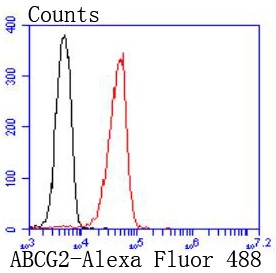ABCG2 antibody
GTX100437
ApplicationsWestern Blot, ImmunoHistoChemistry, ImmunoHistoChemistry Paraffin
Product group Antibodies
TargetABCG2
Overview
- SupplierGeneTex
- Product NameABCG2 antibody
- Delivery Days Customer9
- Application Supplier NoteWB: 1:500-1:3000. IHC-P: 1:100-1:1000. *Optimal dilutions/concentrations should be determined by the researcher.Not tested in other applications.
- ApplicationsWestern Blot, ImmunoHistoChemistry, ImmunoHistoChemistry Paraffin
- CertificationResearch Use Only
- ClonalityPolyclonal
- Concentration1 mg/ml
- ConjugateUnconjugated
- Gene ID9429
- Target nameABCG2
- Target descriptionATP binding cassette subfamily G member 2 (JR blood group)
- Target synonymsABC15, ABCP, BCRP, BCRP1, BMDP, CD338, CDw338, CDw388, EST157481, GOUT1, MRX, MXR, MXR-1, MXR1, UAQTL1, broad substrate specificity ATP-binding cassette transporter ABCG2, ABC transporter, ATP binding cassette subfamily G member 2 (Junior blood group), ATP-binding cassette transporter G2, ATP-binding cassette, sub-family G (WHITE), member 2 (Junior blood group), ATPbinding cassette transporter ABCG2, breast cancer resistance protein, broad substrate specificity ATP-binding cassette transporter ABCG2 isoform 1 (Junior blood group), mitoxantrone resistance-associated protein, multi drug resistance efflux transport ATP-binding cassette sub-family G (WHITE) member 2, placenta specific MDR protein, placenta-specific ATP-binding cassette transporter, urate exporter
- HostRabbit
- IsotypeIgG
- Protein IDQ9UNQ0
- Protein NameBroad substrate specificity ATP-binding cassette transporter ABCG2
- Scientific DescriptionThe membrane-associated protein encoded by this gene is included in the superfamily of ATP-binding cassette (ABC) transporters. ABC proteins transport various molecules across extra- and intra-cellular membranes. ABC genes are divided into seven distinct subfamilies (ABC1, MDR/TAP, MRP, ALD, OABP, GCN20, White). This protein is a member of the White subfamily. Alternatively referred to as a breast cancer resistance protein, this protein functions as a xenobiotic transporter which may play a major role in multi-drug resistance. It likely serves as a cellular defense mechanism in response to mitoxantrone and anthracycline exposure. Significant expression of this protein has been observed in the placenta, which may suggest a potential role for this molecule in placenta tissue. [provided by RefSeq]
- Storage Instruction-20°C or -80°C,2°C to 8°C
- UNSPSC12352203
References
- Kim SH, Fan PW, Hsieh CH, et al. The aqueous extract of brucea javanica reduces tumorigenicity of human lung cancer tumorspheres. Cancer Drug Resist. 2021,4(4):866-880. doi: 10.20517/cdr.2021.58Read this paper
- Shahnawaz S, Nawaz US, Zaugg J, et al. Dysregulated Autophagy Leads to Oxidative Stress and Aberrant Expression of ABC Transporters in Women with Early Miscarriage. Antioxidants (Basel). 2021,10(11). doi: 10.3390/antiox10111742Read this paper
- Onuma S, Manabe A, Yoshino Y, et al. Upregulation of Chemoresistance by Mg(2+) Deficiency through Elevation of ATP Binding Cassette Subfamily B Member 1 Expression in Human Lung Adenocarcinoma A549 Cells. Cells. 2021,10(5). doi: 10.3390/cells10051179Read this paper
- Wang SA, Young MJ, Wang YC, et al. USP24 promotes drug resistance during cancer therapy. Cell Death Differ. 2021,28(9):2690-2707. doi: 10.1038/s41418-021-00778-zRead this paper
- Biswas S, Mahapatra E, Ghosh A, et al. Curcumin Rescues Doxorubicin Responsiveness via Regulating Aurora a Signaling Network in Breast Cancer Cells. Asian Pac J Cancer Prev. 2021,22(3):957-970. doi: 10.31557/APJCP.2021.22.3.957Read this paper
- Fang CH, Lin YT, Liang CM, et al. A novel c-Kit/phospho-prohibitin axis enhances ovarian cancer stemness and chemoresistance via Notch3-PBX1 and β-catenin-ABCG2 signaling. J Biomed Sci. 2020,27(1):42. doi: 10.1186/s12929-020-00638-xRead this paper
- Maruhashi R, Eguchi H, Akizuki R, et al. Chrysin enhances anticancer drug-induced toxicity mediated by the reduction of claudin-1 and 11 expression in a spheroid culture model of lung squamous cell carcinoma cells. Sci Rep. 2019,9(1):13753. doi: 10.1038/s41598-019-50276-zRead this paper
- Ma L, Yin W, Ma H, et al. Targeting claudin-3 suppresses stem cell-like phenotype in nonsquamous non-small-cell lung carcinoma. Lung Cancer Manag. 2019,8(1):LMT04. doi: 10.2217/lmt-2018-0010Read this paper
- Eguchi H, Akizuki R, Maruhashi R, et al. Increase in resistance to anticancer drugs involves occludin in spheroid culture model of lung adenocarcinoma A549 cells. Sci Rep. 2018,8(1):15157. doi: 10.1038/s41598-018-33566-wRead this paper
- Maruhashi R, Akizuki R, Sato T, et al. Elevation of sensitivity to anticancer agents of human lung adenocarcinoma A549 cells by knockdown of claudin-2 expression in monolayer and spheroid culture models. Biochim Biophys Acta Mol Cell Res. 2018,1865(3):470-479. doi: 10.1016/j.bbamcr.2017.12.005Read this paper





